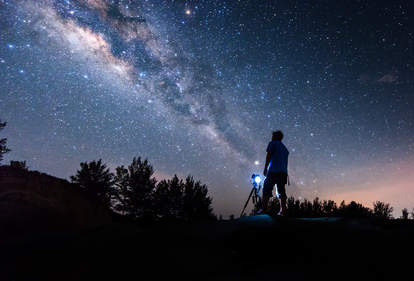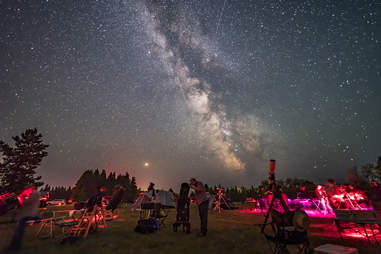Astronomy for Beginners: Tips on How to Start Stargazing – Thrillist

This could easily be you. | Christianto Soning/EyeEm/Getty Images
This could easily be you. | Christianto Soning/EyeEm/Getty Images
Backyard Observatory
It’s a perfect time to get out there and admire everything up there.

The stars are aligning, so to speak. Spring is the optimal time to get back outside and look up at the stars on the regular. On top of that, most of our favorite activities have been taken away by social distancing and widespread stay-at-home orders. You might as well give stargazing a go since all the bars are closed.
Stargazing is a bit of a weird hobby to pick up in many ways. At once, it can seem like the barrier to entry is nothing at all and way too much to handle. All you have to do is step outside and tilt your head back. Now, you’re stargazing. But, also, what the hell are you looking at? How could you ever learn enough to get a grasp on what’s going on up there?
We asked Suresh Sreenivasan, who leads the beginner’s program at the Minnesota Astronomical Society (MAS), what you should know to start enjoying the cosmos from your backyard.
Do you need tools like telescopes and apps?
This is a piece of the puzzle that gets stacked on top of other points below. Do you need a telescope to start stargazing? Not necessarily. Though you can’t see everything with the naked eye. So, it depends on what you’re looking for. If you want to view deep-space objects, you’re going to need a telescope. If you’re looking at planets, you’ll be able to see a lot of them with the naked eye. Venus, Mars, Saturn, and Jupiter are all easily visible. However, even a pair of binoculars will give you a more impressive view, letting you see the rings of Saturn or the crescent of Venus when it’s at its brightest.
However, there are tools available beyond telescopes and binoculars. “The first thing I did when I started is to subscribe to the national magazines,” Sreenivasan said. “The two largest ones are Sky and Telescope and Astronomy.” Though, he notes you can read them online as well. They have details about what you can see in the night sky over the coming weeks. (Of course, Thrillist also has details on many space events throughout the year.)
Additionally, there are apps that use augmented reality to show you what’s in the sky and help you track down objects you want to see. Some of the most popular apps include Sky View, Sky Safari, Star Walk, and Night Sky. “Also, invest in a star atlas,” Sreenivasan said. “There are several out there like Sky & Telescope’s Pocket Sky Atlas. That’s one a lot of beginners use, and I still use it myself when I travel. It’s just a set of star maps. It’s a pretty small book, but it’s a pretty good book.”

Pick your interstellar poison
“The most important thing for an amateur astronomer is finding their niche,” Sreenivasan said. It might seem limiting, but this advice can offer a little relief as well to anyone overwhelmed by the enormity of objects in the sky. “Sometimes people will jump in like I did when I was a kid and think, ‘I’m going to do it all.’ It can get a little daunting. So, do you want to be into planets? Do you want to be into making telescopes? Do you want to be into deep-sky objects and comets? That’s something that’s important to think about as you’re just starting out.”
You don’t necessarily have to do this right away but try things out and start to hone in on what you want to follow most closely. Even professionals tend to not have the bandwidth to be into everything. You don’t need to either.
Where to stargaze
Some of the process of picking your thing might depend on where you’re stargazing and what’s available to you. If you’re sitting in a major city and don’t have a car to get to somewhere genuinely dark, you’ll have a tough time looking for constellations or, say, meteor showers.
The light pollution will wash out your view of most stars. But you might be able to catch some planets from there. “In the city, a lot of times, people will be planet observers, at least that’s the way they start out until they get a bigger scope or they can find a place out in the country,” said Sreenivasan. “That’s where I would start.”
If you’re looking for deep-space objects or meteors, you may want to look into web apps that can help you locate dark skies. DarkSky.org and the Dark Site Finder are good spots to start.

Clubbin’
“As you get into astronomy it helps to join a club,” Sreenivasan said. “You get not only the camaraderie from other people that are just starting out but also a lot of clubs, like ours, have telescopes that you can check out for free. It’s a really great opportunity for people to try out different telescopes, to learn from people, and to find their niche.”
Yes, he is part of MAS, but all of these tips could sound intimidating on your own. However, they are really pretty easy if you go to a star party or club event. You can talk to other beginners as well as experts and start to find your way toward what interests you, even if what interests you is stepping back from the whole scenario and just lazily looking at the stars without any guidance.
Do your own thing
If this starts to seem like a lot to take on, don’t worry about it. This isn’t life or death. You don’t have to get formal. Until I was writing about stargazing for Thrillist, I just kind of went out when I had the chance and tried to enjoy whatever was available to me. It’s a very casual version of what Sreenivasan is talking about here. However, for some people, having no strings attached to your enjoyment of the stars might be the best path into it.
Go outside, look up, enjoy yourself. Crack open a beer in your backyard, and imagine what the world is like beyond Earth’s gravity.
Ready to go stargazing?
Here are all the best stargazing events that you can get out and see this month or you could stay in a stream the northern lights from home.
Sign up here for our daily Thrillist email and subscribe here for our YouTube channel to get your fix of the best in food/drink/fun.
Dustin Nelson is a Senior Staff Writer at Thrillist. Follow him @dlukenelson.






